Think of your Ducati bike as a finely tuned orchestra, where each component plays an essential role in harmony. You might not realize it, but the engine cooling system is critical for maintaining that balance. From radiator size to coolant type, each specification contributes to your bike's performance and longevity. So, what are the key features that guarantee optimal cooling? Let's explore the top ten engine cooling specs that every Ducati owner should know to keep their machine in peak condition.
Key Takeaways
- Optimal engine temperature range for Ducati bikes is 160°F to 220°F, crucial for performance and longevity.
- Larger radiators enhance heat dissipation and airflow, improving cooling efficiency during demanding rides.
- Recommended coolant types, like Ducati Genuine Coolant, ensure proper thermal conductivity and engine protection.
- Regular maintenance, including coolant level checks and system flushing, prevents overheating and prolongs engine life.
Liquid Cooling System
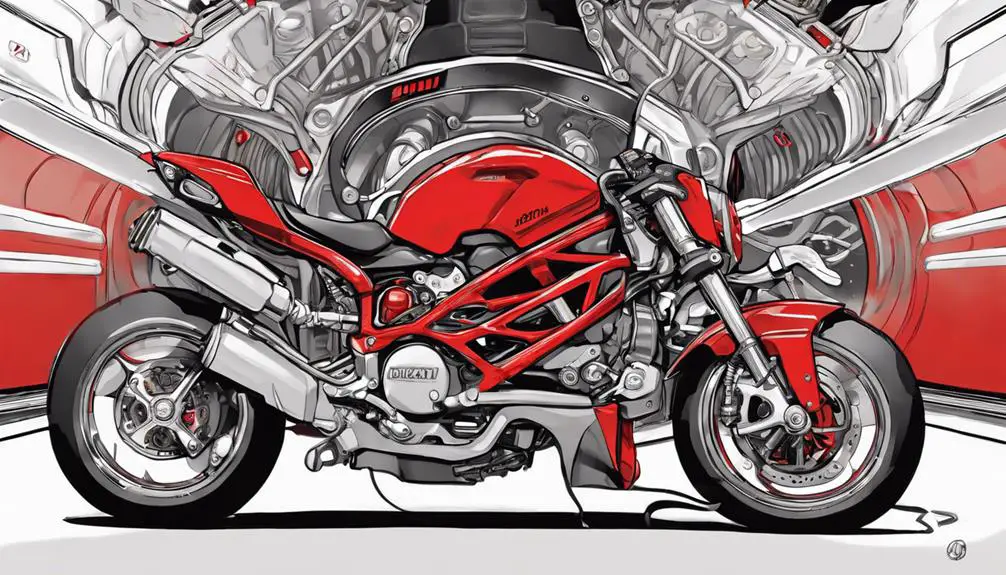
Ducati's liquid cooling system efficiently regulates engine temperature, ensuring peak performance during your rides. When you twist the throttle, you want your bike to respond without hesitation, and this system helps achieve that. By circulating coolant through the engine, it absorbs excess heat, preventing overheating and allowing your Ducati to release its power consistently.
You'll appreciate how this system maintains ideal temperatures, especially on long journeys or during spirited rides through winding roads. This innovative cooling method enhances your overall riding experience. It not only boosts your bike's performance but also contributes to its longevity.
As you push your limits, the liquid cooling system silently works in the background, providing the reliability you crave. You won't have to worry about engine stress or loss of power; instead, you can focus on the exhilarating freedom of the open road.
Radiator Size and Efficiency
When it comes to radiator size and efficiency, you'll want to take into account the dimensions and design that best suit your Ducati.
The cooling fluid capacity plays a vital role in maintaining ideal temperatures, while effective airflow and heat dissipation are key to preventing overheating.
Understanding these factors will help you maximize your bike's performance on the road.
Radiator Dimensions and Design
The radiator's dimensions and design play an essential role in ensuring ideal engine cooling efficiency for your Ducati bike. When you're pushing the limits on open roads or racetracks, you need a radiator that can handle the heat. A larger radiator often means more surface area for heat dissipation, allowing your engine to run cooler under pressure.
However, it's not just about size. The design—such as the fin density and tube arrangement—affects airflow and coolant flow, maximizing cooling performance. Well-designed radiators optimize heat transfer, ensuring your bike doesn't overheat when you're seeking freedom on two wheels.
You might also want to evaluate the weight of the radiator. While a bigger radiator can be beneficial, it shouldn't add unnecessary bulk to your ride. An efficient design strikes a balance between size and weight, allowing for agile handling without compromising cooling performance.
Cooling Fluid Capacity
Understanding the cooling fluid capacity is essential for maximizing your radiator's size and efficiency, as it directly impacts your bike's ability to maintain engine temperatures during demanding rides. The right amount of coolant guarantees that your engine remains cool, allowing you to push your Ducati to its limits without fear of overheating.
When you choose a radiator that matches your bike's cooling fluid capacity, you enhance its performance. A radiator that's too small might struggle to dissipate heat, leading to potential engine damage. On the other hand, a radiator that's too large can add unnecessary weight and complexity.
You should also consider the quality of the coolant. High-performance fluids can provide superior thermal conductivity, helping your engine maintain ideal running temperatures.
Regularly check your coolant levels and replace the fluid as needed, guaranteeing your system runs smoothly. If you're planning a long ride or an intense track day, double-checking your cooling fluid capacity can be the difference between a thrilling adventure and a frustrating breakdown.
Embrace this knowledge, and you'll experience the freedom of riding without limitations, knowing your Ducati is equipped for any challenge.
Airflow and Heat Dissipation
Maximizing airflow through your Ducati's radiator is essential for efficient heat dissipation, as it directly affects your bike's cooling performance during intense rides.
The size and placement of your radiator play a significant role in how effectively it can manage heat. A larger radiator generally increases the surface area for heat exchange, allowing more air to flow through and cool the engine.
However, it's not just about size; the design and efficiency of the radiator matter too. Look for models with optimized fin designs that enhance airflow. These fins increase the turbulence of the air passing through, maximizing cooling efficiency without the need for additional space.
You should also consider the bike's fairing design. An aerodynamic fairing can guide airflow directly towards the radiator, boosting cooling performance during your high-speed adventures. Verify your bike's vents are clear of obstructions, as even minor debris can impede airflow.
Ultimately, understanding the relationship between radiator size, airflow, and heat dissipation empowers you to keep your Ducati operating at peak performance. Feel the freedom of the open road, knowing your bike can handle the heat!
Cooling Fan Specifications
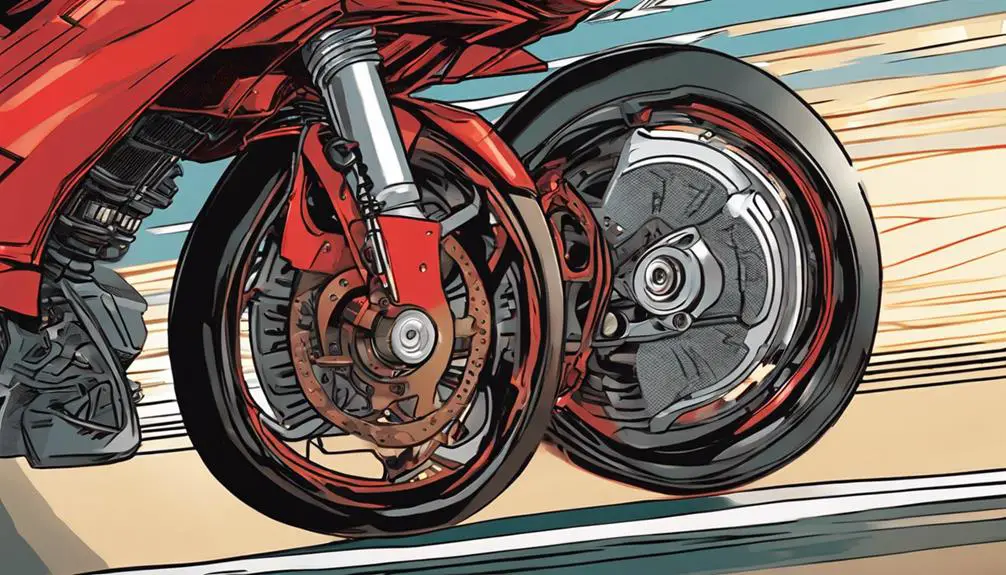
When it comes to cooling fan specifications, you'll want to take into account several key factors.
The fan motor power, cooling efficiency rating, and noise level specifications all play a significant role in your bike's performance.
Understanding these elements helps guarantee your Ducati stays cool and runs smoothly.
Fan Motor Power
Ducati's cooling fans typically operate with a motor power ranging from 30 to 50 watts, guaranteeing efficient heat dissipation during rides. This power range strikes a balance between performance and energy consumption, allowing you to maximize your bike's potential without draining its resources. When you're tearing through the open road, you want to know your engine's running cool, and these fans help make that happen.
The design of the fan motors plays a vital role in how effectively they cool your engine. With robust construction, they're built to withstand the rigors of high-performance riding. You'll find that these fans kick in when the engine temperature rises, providing timely relief to prevent overheating.
Choosing a Ducati means you're embracing a philosophy of freedom and exhilaration, and part of that experience hinges on reliable engine performance. With the right fan motor power, you can ride with confidence, knowing your bike is equipped to handle the heat.
Cooling Efficiency Rating
The cooling efficiency rating of Ducati's fan specifications assures that your engine stays within ideal temperature ranges, enhancing both performance and longevity.
When you're riding, you want to feel that exhilarating freedom, and a properly cooled engine allows you to tap into your bike's full potential without the worry of overheating.
Ducati's fans are engineered for maximum airflow and thermal management. They kick in at the right moments, maintaining peak temperatures even in the most demanding conditions.
This means you can push your bike to its limits on a twisting mountain road or during a long highway cruise, all while knowing the engine's kept safe and sound.
The clever design of the cooling systems minimizes the risk of heat-related issues, so you can focus on the thrill of the ride.
Plus, with efficient cooling, fuel consumption improves, giving you more range to explore the open road.
In essence, Ducati's cooling efficiency rating isn't just a number; it's a commitment to your riding experience.
You deserve a bike that performs flawlessly, and with these specs, you're not just riding – you're liberating yourself on two wheels.
Noise Level Specifications
Engine cooling fans are designed to operate quietly, guaranteeing that you can enjoy your ride without intrusive noise distractions. Ducati understands that the thrill of the open road should be accompanied by the soothing sound of the engine, not the whirring of a cooling system. That's why their fans are engineered to maintain peak performance while keeping noise levels to a minimum.
When you rev up your bike, you shouldn't have to compete with the sound of your cooling fan. Ducati's noise level specifications focus on delivering a whisper-quiet operation, allowing you to fully immerse yourself in the experience. This means you can feel the power of your ride without the annoyance of excess noise.
The carefully crafted design of these fans guarantees efficient airflow and cooling, all while adhering to strict noise regulations. You can ride confidently, knowing that your bike's cooling system won't disrupt your adventure.
Embrace the freedom that comes with riding a Ducati, where every aspect—from engine performance to cooling efficiency—works harmoniously to elevate your journey. Choose a Ducati, and ride with the peace and tranquility you deserve.
Thermostat Functionality
A thermostat regulates the engine's temperature, guaranteeing ideal performance by maintaining the right coolant flow. This little device plays a vital role in your Ducati's engine cooling system, allowing it to operate smoothly and efficiently. By controlling when the coolant circulates, the thermostat helps prevent overheating and guarantees your ride remains powerful and liberating.
Here's what you should know about thermostat functionality:
- Temperature Control: It opens and closes at specific temperatures, allowing the engine to reach peak running conditions.
- Enhanced Performance: A functioning thermostat boosts engine efficiency, meaning you get more power when you need it.
- Longevity: It helps reduce wear and tear on engine components, extending the life of your bike.
Understanding the thermostat's role can empower you as a rider, giving you the confidence to push your Ducati to its limits while guaranteeing it stays cool and performing at its best.
Enjoy the freedom that comes with knowing your bike's inner workings!
Coolant Type and Capacity
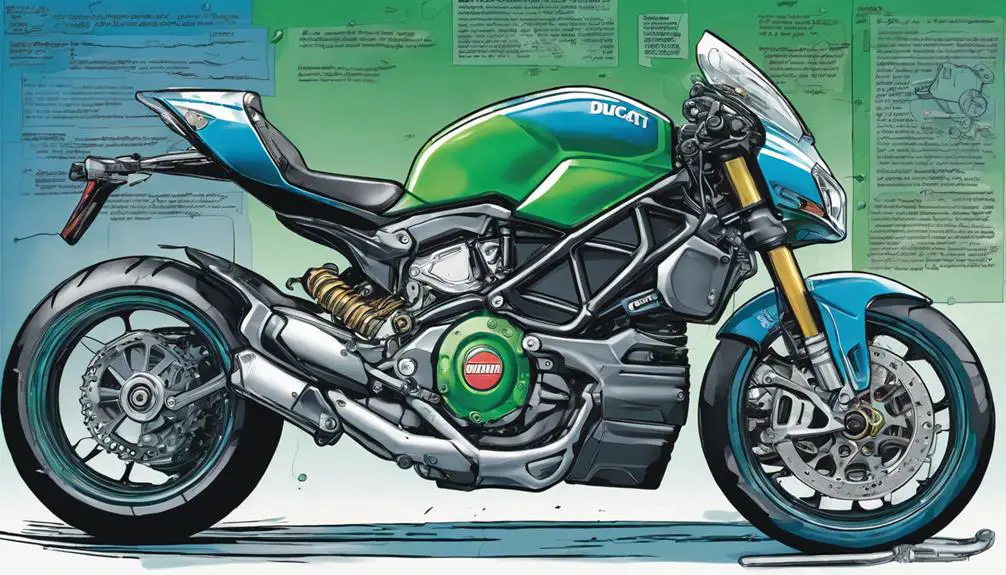
When it comes to keeping your Ducati running smoothly, the right coolant type and capacity are essential.
Each model has specific requirements that you need to follow for peak performance.
You'll also want to know some maintenance tips to guarantee your cooling system stays in top shape.
Recommended Coolant Types
Choosing the right coolant type for your Ducati bike guarantees peak engine performance and longevity. You want to keep your engine cool and running smoothly, so selecting the right coolant is crucial. Most Ducati models recommend using a high-quality ethylene glycol-based coolant, which offers excellent thermal stability and protection against corrosion.
Here are some recommended coolant types to take into account:
- Ducati Genuine Coolant: Formulated specifically for Ducati engines, this coolant meets all necessary specifications.
- Pre-Mixed Coolant: Convenient and ready-to-use, it provides ideal cooling without the hassle of mixing.
- Silicate-Free Coolant: This type helps prevent deposits and assures the longevity of your engine's components.
Always check your owner's manual for specific recommendations. Using the right coolant not only enhances your bike's performance but also contributes to a smoother ride.
Capacity Specifications by Model
Knowing the coolant type is just as important as understanding the capacity specifications for your specific Ducati model to guarantee peak engine performance. Each model has its own unique requirements, and you must familiarize yourself with these details to access your bike's full potential.
For example, the Ducati Panigale V4 typically requires around 2.5 liters of coolant, while the Monster 1200 may only need about 2.0 liters. The Multistrada 1260, a versatile choice for adventure enthusiasts, usually calls for approximately 2.7 liters. These specifications can vary slightly based on year and modifications, so it's essential to refer to your owner's manual for the most accurate information.
When you understand your bike's coolant capacity, you can make sure it runs cooler and smoother, enhancing your riding experience.
Choosing the right coolant type, as previously mentioned, complements this knowledge by promoting ideal thermal efficiency.
Coolant Maintenance Tips
Regularly checking and maintaining your Ducati's coolant type and capacity guarantees peak engine performance and longevity.
Using the right coolant is essential, as it not only prevents overheating but also protects your engine from corrosion. Always refer to your owner's manual for the specific coolant type recommended for your model.
Here are some handy tips to streamline your coolant maintenance:
- Pick the Right Coolant: Use only the recommended coolant type, whether it's ethylene glycol-based or something else.
- Check the Levels: Inspect your coolant level regularly, especially before long rides. It should be within the specified range.
- Flush When Needed: Consider flushing your cooling system every couple of years to remove any buildup and contaminants.
Engine Temperature Range
Ducati engines typically operate efficiently within a temperature range of 160°F to 220°F (70°C to 104°C). Staying within this range is essential for releasing the full potential of your bike's performance.
When your engine runs cool, it can lose efficiency and responsiveness, diminishing that exhilarating ride you crave. Conversely, if temperatures soar beyond 220°F, you risk overheating, which could lead to engine damage or failure.
To keep your ride liberating, always monitor the engine temperature. Use your bike's dashboard to stay informed and make adjustments as needed.
If you notice the temperature creeping up, it's time to reconsider your riding style or check your cooling system. Remember, the engine's temperature isn't just a number—it's a direct reflection of how well your bike performs.
Heat Exchanger Design
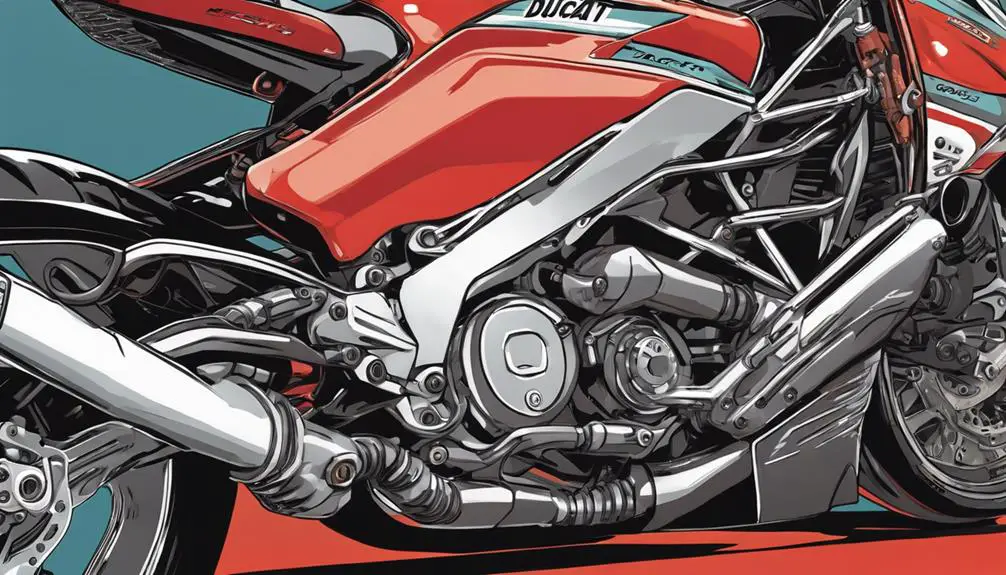
The heat exchanger design in your Ducati plays an essential role in maintaining ideal engine temperatures during rides. This component efficiently transfers heat away from the engine, guaranteeing it operates at peak performance. A well-designed heat exchanger allows you to release the full potential of your bike without the worry of overheating.
Here are some key features to take into account in your heat exchanger design:
- Material Quality: Lightweight materials like aluminum improve heat dissipation while keeping weight down.
- Cooling Efficiency: A larger surface area enhances heat transfer, helping your engine stay cool even under stress.
- Aerodynamic Shape: Streamlined designs reduce drag, allowing for better airflow and cooling performance.
When you understand the significance of your Ducati's heat exchanger, you can ride with confidence. This design isn't just about keeping your engine cool; it's about enhancing your experience on the road.
Hose and Fitting Durability
Durability in hoses and fittings is essential for guaranteeing your Ducati's cooling system operates seamlessly during every ride. You need components that can withstand the high pressures and temperatures generated by your bike's engine. Choosing high-quality materials, like reinforced silicone or rubber, assures that your hoses won't crack or degrade over time.
When you're out on the road, the last thing you want to worry about is a coolant leak due to subpar fittings. Opt for stainless steel or heavy-duty plastic fittings that resist corrosion and maintain a solid seal. It's all about freedom—freedom from the anxiety of breakdowns or repairs that could ruin your ride.
Regular inspection is key. Check for any signs of wear, kinks, or soft spots in your hoses. Addressing these issues early can save you from being sidelined on your next adventure. Remember, the more you invest in the durability of your hoses and fittings, the more you empower yourself to enjoy the open road without limitations. So, embrace the journey and guarantee your cooling system is as robust as your passion for riding.
Airflow Management Features
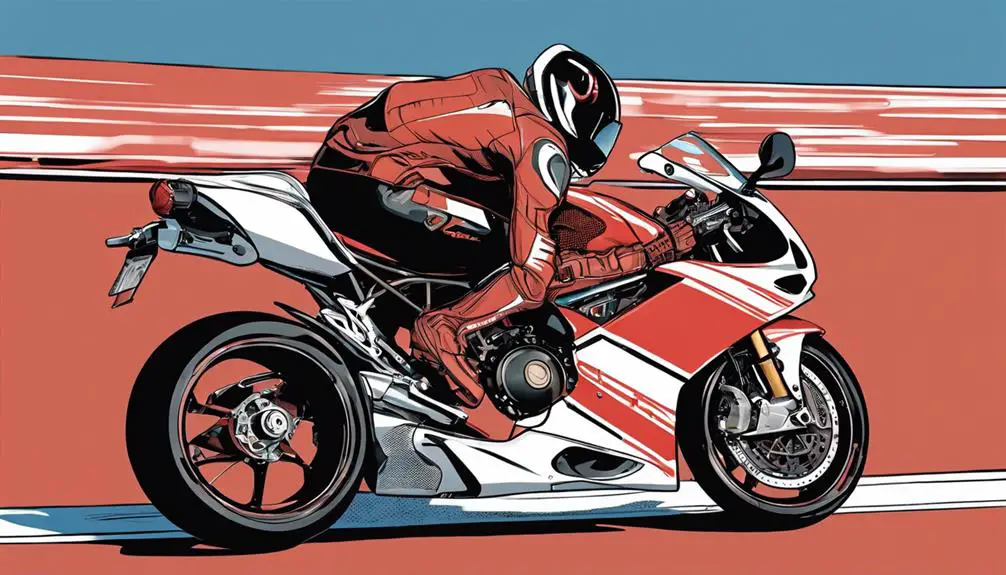
Optimizing airflow is essential for maintaining your bike's engine temperature and overall performance. Ducati bikes are designed with innovative airflow management features that help keep your engine cool while you hit the open road. These features guarantee that your ride remains powerful and responsive, allowing you to feel the freedom that comes with riding a Ducati.
Here are some key airflow management features you'll appreciate:
- Intake Ducts: Strategically positioned to funnel cool air directly to the engine, enhancing combustion efficiency.
- Radiator Placement: Optimized for maximum exposure to airflow, guaranteeing effective heat dissipation even during high-speed rides.
- Bodywork Design: Sleek and aerodynamic shapes that reduce drag, allowing air to flow smoothly around the bike.
With these features, you're not just riding; you're experiencing the thrill of a finely-tuned machine that responds to your every command.
Embrace the road ahead, knowing your bike is equipped to handle the heat of your adventurous spirit!
Maintenance and Service Recommendations
Maintaining your Ducati's cooling system is key to guaranteeing peak performance, so regular service checks are essential for long-lasting engine efficiency.
Start by inspecting your coolant levels frequently; low coolant can lead to overheating and engine damage. Make it a habit to flush the cooling system as recommended in your owner's manual; this helps to remove debris and prevent corrosion.
Check your hoses for wear and tear. Cracks or leaks can compromise the system's integrity. Replace any damaged hoses immediately.
Don't forget to inspect the radiator for blockages and clean it regularly to promote maximum airflow.
During every service, verify the thermostat is functioning properly—it plays a critical role in regulating temperature. If you notice any fluctuations in temperature readings while riding, it's time for a closer inspection.
Lastly, trust a certified mechanic for more extensive maintenance. They'll have the tools and expertise to keep your system in top shape.
Frequently Asked Questions
How Often Should I Check My Coolant Levels?
You should check your coolant levels regularly, ideally every couple of weeks, especially if you ride frequently.
Keeping an eye on it helps prevent overheating and guarantees your bike runs smoothly.
If you notice any drops in the level or leaks, top it off immediately.
Don't wait for a long ride to discover an issue; staying proactive gives you the freedom to ride without worrying about potential breakdowns.
What Are Symptoms of a Failing Cooling System?
Imagine you're cruising down a winding road, and suddenly your bike starts to overheat. That's a sign your cooling system might be failing.
Other symptoms include a sweet smell from leaking coolant, fluctuating temperature gauges, or steam rising from the engine.
If you notice any of these issues, don't ignore them! Addressing a failing cooling system early can save you from costly repairs and keep your ride smooth and enjoyable.
Can I Use Regular Water Instead of Coolant?
You might think using regular water instead of coolant is a quick fix, but it isn't.
Water can boil away too quickly and freeze, causing serious damage. It doesn't provide the same anti-corrosive properties that coolant does, either.
You deserve a reliable ride, so always use the proper coolant for your engine. It'll keep everything running smoothly and protect your investment.
Don't compromise on quality; your bike will thank you!
How Does Riding Style Affect Engine Cooling?
Just like a dancer matches their moves to the rhythm, your riding style directly influences engine cooling.
When you ride aggressively, you push the engine harder, generating more heat. Conversely, a smoother, more relaxed approach allows for better airflow and cooling.
By adapting your style, you can help maintain ideal temperatures, ensuring your engine runs efficiently.
Embrace the ride, and let your choices liberate both you and your machine from overheating.
Are Aftermarket Cooling Parts Compatible With My Ducati?
When you're considering aftermarket cooling parts for your Ducati, compatibility is key. You'll want to research specific parts designed for your model.
Many aftermarket options work well, but some mightn't fit or function ideally. Always check reviews and consult with other riders or mechanics who've made similar upgrades.
Don't hesitate to explore your options, as the right enhancements can greatly improve your ride's performance and keep that engine cool on those liberating journeys!
Conclusion
In conclusion, mastering the mechanics of Ducati's engine cooling systems is essential for peak performance.
By prioritizing precise radiator sizes, powerful cooling fans, and proper coolant capacities, you can guarantee your bike stays cool under pressure.
Don't forget to regularly maintain hoses and fittings while efficiently managing airflow through sleek designs.
Staying savvy about these specs will safeguard your ride, securing stellar performance and extending its lifespan.
Keep your Ducati cool, and it'll continue to conquer the roads!